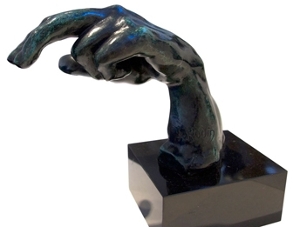Stanford Medical Professor Teaches through the Art of Rodin
 Rodin Sculpture Featured at Stanford Medical Exhibition
Rodin Sculpture Featured at Stanford Medical ExhibitionJames Chang fell in love with the Rodin Sculpture Garden at Stanford when he was an undergraduate. Later, while training in plastic and reconstructive surgery at the Stanford University School of Medicine, he visited the Cantor Arts Center with his family on Thursday evenings, where they would enjoy dinner in the café and then the art.
His fascination for the work of the famous French artist Auguste Rodin (1840–1917) grew as Dr. Chang saw signs in the sculptures of the medical conditions he was learning to identify. Now as a professor in Stanford’s medical school, he shows images of Rodin’s sculptures of hands to medical students and hand surgery trainees, asking them to make diagnoses and hoping the artworks will make learning more fun and memorable.
Dr. Chang’s enthusiasm for this art has also fueled his undergraduate seminar, “Surgical Anatomy of the Hand: From Rodin to Reconstruction” with students studying the hands that Rodin created and their perceived medical conditions aided by advanced technology. Three-dimensional scans of the sculptures combined with CT scans of patients’ bones, nerves and blood vessels create a new “augmented reality” that reveals the pathologies beneath the bronze and even allows students to perform virtual surgery.
“Inside Rodin’s Hands: Art, Technology, and Surgery” opened at the Cantor April 9 and continues through August 3. The exhibition, unique in how it merges art and science, involved an unprecedented collaboration between four diverse groups at Stanford: the Cantor Arts Center, Dr. Chang and his students, the Division of Clinical Anatomy, and the Lane Medical Library.
“This exhibition brings together the best of Stanford with a cross-disciplinary set of contributors,” said Cantor Director Connie Wolf. “We were all inspired by Dr. Chang and his passion. Outstanding individuals from the anatomy department at the School of Medicine contributed unique, cutting-edge technology that is changing how surgery is taught throughout the world.” The exhibition allows visitors to experience Rodin’s hands as Dr. Chang’s students do in the seminar. After an introduction to Rodin, his art, and his appreciation of the hand as an especially expressive part of the human body, the exhibition presents the modern surgeon’s diagnostic process. Rodin bronzes on display are accompanied by evaluations of the sculptures’ perceived conditions, written by Dr. Chang and his students. Photographs of patients’ hands with the same conditions—Dupuytrens contracture, Apert syndrome, Charcot-Marie-Tooth disease, ganglion cyst, thumb amputation, fracture and stiff joint— illustrate how surgeons correct the conditions. Visitors see what lies “beneath the skin” of the bronze hands—the underlying anatomy that Dr. Chang imagined when he encountered the sculptures at the Cantor—through the use of augmented reality. By rotating an iPad in an arc around three of Rodin’s hand sculptures, visitors can see computer-generated graphics of bones, nerves and blood vessels from varying angles.
Dr. Chang uses this technology in his class because it gives his students a sense of the hand’s three-dimensional structure, an experience otherwise limited to time working on actual cadavers.
Dr. Chang cited the unprecedented collaboration for the success of the overall project, the seminar and the exhibition. He added, “I wanted to participate in this exhibition for the same reason I introduced Rodin into my seminar: to get students in the humanities excited about the sciences, and to get doctors to step out of the hospital to appreciate art. I have found that artists and surgeons appreciate human anatomy with equal passion.”
Resources:
Also in this Issue:
- Bronze’s Role in the American West
- Musings with Morningstar Metalworks
- Gage Designs: Creating Jewelry And Instruction with Metal Clay
- Ildanach: Handmade Wearable Art Forged with Spirit And Character
- Stanford Medical Professor Teaches through the Art of Rodin
